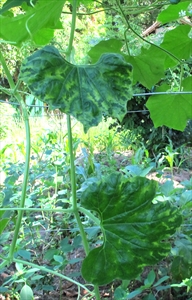Banana mosaic, cucumber mosaic, infectious chlorosis.
Pacific Pests, Pathogens, Weeds & Pesticides - Online edition
Pacific Pests, Pathogens, Weeds & Pesticides
Banana mosaic (100)
Cucumber mosaic cucumovirus. The abbreviation for this virus is CMV. There are a number of strains.
In temperate, sub-tropical and tropical countries. Cucumber mosaic virus has been recorded in banana, in the following countries in Oceania: Australia, Cook Islands, Fiji, French Polynesia, Kiribati, Samoa, Solomon Islands, and Tonga.
A virus with a large host range. It is especially common in the families Cucurbitaceae, Fabaceae and Solanaceae. In Pacific islands, the following crops are common hosts: banana, cantaloupe melon, capsicum, chilli, pumpkin, snake gourd, tomato and watermelon. Cucumber mosaic virus has also been found in weeds, e.g., Ruellia, Synedrella, Mikania and Commelina.
Cucumber mosaic virus is a common virus widespread in many crops. It causes mottles and mosaics, terms used to describe patterns of light and dark green on the leaves. In tomato, the virus can cause a 'fern leaf' symptom - narrow, twisted, distorted leaves.
In banana, there are yellow streaks and flecks, sometimes with mild distortion (Photos 1&2). Usually, symptoms occur on a few leaves only, after which apparently healthy leaves are produced.
By contrast, in dicotyledonous crops, leaf symptoms vary. For example, in snake gourd, (Photos 3&4), some leaves have faint spots and blotches roughly following the veins, others have large areas of yellow, or distortions with patches of yellow and darker green.
Cucumber mosaic virus is spread by seed in some species, but rates are usually low, e.g., in tomato. It is transmitted rapidly in a non-persistent way by several aphid species. This means it takes only a few seconds for aphids to acquire the virus, and then they can pass it on when they next feed. However, they quickly lose the ability to spread the virus in this way; this is what is meant by 'non-persistent'. The virus does not multiply inside aphids.
An important fact about aphid transmission of viruses is that aphids can spread them even though they do not stay and breed on a particular crop. Aphids often land on a crop, feed and then fly on if the crop is not to their liking. In the process, however, the plants become infected with virus.
The transfer of sap from an infected plant to one that is healthy can also spread the virus, but this is thought to be less important than spread by aphids.
Impact depends on the host, the strain of the virus, and the weather. In most crops, the symptoms are indistinct, especially in banana, chilli, tomato and pumpkin, and Cucumber mosaic virus causes a minor disease. By contrast, it causes a serious dieback disease of kava (see Fact Sheet no. 160), and control measures are needed.
In Pacific island countries, Cucumber mosaic virus has been found in plants with other viruses, e.g., Zucchini yellow mosaic virus, Papaya ringspot virus, Tobacco mosaic virus and Tomato mosaic virus.
Look for leaves with light and dark green streaks or patches. In some hosts, the leaves may be distorted.
Control of Cucumber mosaic virus is difficult. It has a wide host range, insecticides do not prevent its spread, and there are several strains. Once plants are infected and show symptoms there is no way to make them healthy again, so it is important to prevent infection.
CULTURAL CONTROL
Before planting:
- Only use virus-free seed. If seed is kept from a previous crop, make sure it is taken from plants that appear free from virus symptoms.
- Avoid planting any of the crops known to be susceptible to Cucumber mosaic virus next to older crops of susceptible species; if you do, aphids will quickly move the virus to the new crop. Common hosts are cowpeas, squash and cucumbers.
- In particular, avoid planting down-wind from an old crop; adult winged aphids can be carried by wind onto the healthy crop.
- Check plants in the nursery for Cucumber mosaic virus symptoms; if found, remove and destroy the plants. Check the plants remaining in the nursery frequently (every 2-3 days) as well as those planted in the field.
- But, be careful when handling infected seedlings. Be careful, too, when transplanting seedlings to the field. Wash hands and tools frequently with soap and water.
During growth:
- Use a trap crop. Plant resistant varieties, resistant types of vegetables, or root crops that do not become infected, around the susceptible crop; by the time the aphids reach the susceptible varieties they will have fed and 'lost' the virus.
- Weed around nurseries and crops in the field as many weeds are hosts of Cucumber mosaic virus. Note that some weeds do not show symptoms, but can still be a source of the virus.
After harvest:
- Collect and destroy the remains of the harvest and other plant debris, and burn them.
RESISTANT VARIETIES
There are varieties of cucumber and zucchini that have some resistance to Cucumber mosaic virus.
CHEMICAL CONTROL
Do not use insecticides. By the time the chemicals have killed any aphids present, the insects have already fed and spread the virus. Sprays of mineral oil may be useful to repel aphids, and they also interfere with virus transmission.
AUTHORS Helen Tsatsia & Grahame Jackson
Information from (including Photo 1) Diseases of fruit crops in Australia (2009). Editors, Tony Cooke, et al. CSIRO Publishing.
Produced with support from the Australian Centre for International Agricultural Research under project PC/2010/090: Strengthening integrated crop management research in the Pacific Islands in support of sustainable intensification of high-value crop production, implemented by the University of Queensland and the Secretariat of the Pacific Community.







